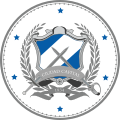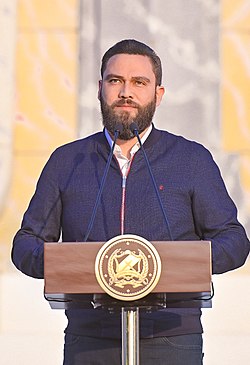| No. | Portrait | Greater Mayor | Took office | Left office | Time in office | Ref |
|---|
| – |  | Diego Galán [ es ]
(1530–1600)
Interim Mayor | 1579 | 1580 | c.1 year, 0 days | |
|---|
| – |  | Juan Cisneros de Reynoso y Valverde [ es ]
(1530–?)
Interim Mayor | 1580 | 1581 | c.1 year, 0 days | [5] |
|---|
| 31 |  | Alonso de Nava [ es ]
(1520–1590) | 1581 | 1586 | c.5 years, 0 days | [5] |
|---|
| 32 |  | Lucas Pinto [ es ]
(1540–1588) | 1586 | 1588 | c.2 years, 0 days | [5] |
|---|
| – |  | Diego de Paz y Quiñones [ es ]
(1540–1630)
Interim Mayor | 1588 | 1590 | c.2 years, 0 days | [5] |
|---|
| – |  | Pedro Girón de Alvarado [ es ]
(1545–1603)
Interim Mayor | 1590 | 1593 | c.3 years, 0 days | [5] |
|---|
| – |  | Luis de Fuentes y de la Cerda [ es ]
(1570–?)
Interim Mayor | 1593 | 1594 | c.1 year, 0 days | [5] |
|---|
| 33 |  | Martín de Vega y Aceituno [ es ]
(?–?) | 1594 | 1596 | c.2 years, 0 days | [5] |
|---|
| 34 |  | Francisco Osorio y Ávalos [ es ]
(1560–?) | 1596 | 1603 | c.7 years, 0 days | [5] |
|---|
| 35 |  | Juan Guiral de Mencis [ es ]
(?–1610) | 1603 | 1607 | c.4 years, 0 days | [5] |
|---|
| 36 |  | Andrés Dorantes de Laguna [ es ]
(?–1658) | 1607 | 1614 | c.7 years, 0 days | [5] |
|---|
| 37 |  | Pedro Farfán de los Godos [ es ]
(?–1623) | 1614 | 1620 | c.6 years, 0 days | [5] |
|---|
| 38 |  | Pedro de Aguilar Lazo de la Vega [ es ]
(1585–?) | 1620 | 1626 | c.6 years, 0 days | [5] |
|---|
| 39 |  | Pedro de Torres y Toledo [ es ]
(?–1656) | 1626 | 1631 | c.5 years, 0 days | [5] |
|---|
| 40 |  | Eugenio de Rueda y Góngora [ es ]
(1580–?) | 1631 | 1635 | c.4 years, 0 days | [5] |
|---|
| 41 |  | Juan Sarmiento de Valderrama [ es ]
(1590–1665) | 1635 | 1641 | c.6 years, 0 days | [5] |
|---|
| – |  | Martín Duarte Fernández [ es ]
(1575–1642)
Interim Mayor | 1641 | 1642 | c.1 year, 0 days | [5] |
|---|
| – |  | Antonio Justiniano Chavarri
(?–?)
Interim Mayor | 1642 | 1647 | c.5 years, 0 days | |
|---|
| 42 |  | Juan Martínez Téllez de los Ríos
(1590s–1657) | 1647 | 1652 | c.5 years, 0 days | |
|---|
| 43 |  | José Portal de Artavia
(?–?) | 1652 | 1657 | c.5 years, 0 days | |
|---|
| 44 |  | Francisco Andrabeja
(?–?) | 1657 | 1659 | c.2 years, 0 days | |
|---|
| – |  | Lupercio de Espés y Brizuela
(?–?)
Interim Mayor | 1659 | 1663 | c.4 years, 0 days | |
|---|
| 45 |  | Pedro de Saravelles
(?–?) | 1663 | 1670 | c.7 years, 0 days | |
|---|
| 46 |  | Martín de Revollar
(?–?) | 1670 | 1673 | c.3 years, 0 days | |
|---|
| 47 |  | Juan de Miranda
(?–?) | 1673 | 1680 | c.7 years, 0 days | |
|---|
| – |  | Diego de Gamarra y Balcárcel
(?–?)
Interim Mayor | 1680 | 1684 | c.4 years, 0 days | |
|---|
| 48 |  | Pedro Calvo del Risco
(?–?) | 1684 | 1689 | c.5 years, 0 days | |
|---|
| 49 |  | José de Arría y Hurtado
(?–?) | 1689 | 1694 | c.5 years, 0 days | |
|---|
| 50 |  | José Calvo de Lara
(?–?) | 1694 | 1699 | c.5 years, 0 days | |
|---|
| 51 |  | Bartolomé Gálvez Corral
(?–?) | 1699 | 1703 | c.4 years, 0 days | |
|---|
| – |  | Juan Antonio Ruiz de Bustamante [ es ]
(1670–1725)
Interim Mayor | 1703 | 1706 | c.3 years, 0 days | |
|---|
| – |  | Francisco Chacón Medina y Salazar
(?–?)
Interim Mayor | 1706 | 1708 | c.2 years, 0 days | |
|---|
| 52 |  | Nicolás de Segovia Parada y Verdugo
(?–?) | 1708 | 1710 | c.2 years, 0 days | |
|---|
| – |  | Francisco Rodríguez Franco
(?–?)
Interim Mayor | 1710 | 1715 | c.5 years, 0 days | |
|---|
| 53 |  | Pedro de Oyanarte
(?–1716) | 1715 | 1716 | c.1 year, 0 days | |
|---|
| – |  | Estebán de Larramendi
(?–?)
Interim Mayor | 1716 | 1718 | c.2 years, 0 days | |
|---|
| 54 |  | José Llanes Robles
(?–?) | 1718 | 1721 | c.3 years, 0 days | |
|---|
| – |  | Pedro de Doralea
(?–1723)
Interim Mayor | 1721 | 1723 | c.2 years, 0 days | |
|---|
| – |  | Rodrigo Salgado
(?–?)
Interim Mayor | 1723 | 1724 | c.1 year, 0 days | |
|---|
| 55 |  | Pedro de Echevers
(?–?) | 1724 | 1729 | c.5 years, 0 days | |
|---|
| 56 |  | Antonio González Manrique [ es ]
(1695–1738) | 1729 | 1734 | c.5 years, 0 days | |
|---|
| 57 |  | Cristóbal Marcos de Gálvez Corral
(?–?) | 1734 | 1737 | c.3 years, 0 days | |
|---|
| – |  | Manuel de Gálvez y Corral
(?–?)
Interim Mayor | 1737 | 1740 | c.3 years, 0 days | |
|---|
| 58 |  | Esteban Sánchez Calderón
(?–?) | 1740 | 1744 | c.4 years, 0 days | |
|---|
| 59 |  | Isidro Díaz de Vivar
(?–?) | 1744 | 1751 | c.7 years, 0 days | |
|---|
| 60 |  | Domingo Soto Bermúdez
(?–?) | 1751 | 1756 | c.5 years, 0 days | |
|---|
| – |  | Manuel Amate
(?–?)
Interim Mayor | 1756 | 1757 | c.1 year, 0 days | |
|---|
| 61 |  | Bernabé de la Torre Trassierra
(?–1773) | 1757 | 1759 | c.2 years, 0 days | |
|---|
| – |  | Francisco Ignacio Chamorro [ es ]
(1719–1785)
Interim Mayor | 1759 | 1761 | c.2 years, 0 days | |
|---|
| – |  | Manuel Fradique y Goyena [ es ]
(?–?)
Interim Mayor | 1761 | 1763 | c.2 years, 0 days | |
|---|
| – |  | José Jacinto Palomo y Rodríguez
(?–?)
Interim Mayor | 1763 | 1765 | c.2 years, 0 days | |
|---|
| 62 |  | Cristóbal Marcos de Gálvez Corral
(?–?) | 1765 | 1766 | c.1 year, 0 days | |
|---|
| – |  | Manuel Fradique y Goyena [ es ]
(?–?)
Interim Mayor | 1766 | 1771 | c.5 years, 0 days | |
|---|
| 63 |  | Bernabé de la Torre Trassierra
(?–1773) | 1771 | 1773 | c.2 years, 0 days | |
|---|
| – |  | Francisco Antonio de Aldana y Guevarra
(?–?)
Interim Mayor | 1773 | 1774 | c.1 year, 0 days | |
|---|
| – |  | Melchor de Mencos y Barón de Berrieza [ es ]
(?–?)
Interim Mayor | 1774 | 1777 | c.3 years, 0 days | |
|---|
| – |  | Manuel Fradique y Goyena [ es ]
(?–?)
Interim Mayor | 1777 | 1779 | c.2 years, 0 days | |
|---|
| 64 |  | Manuel Fradique y Goyena [ es ]
(?–?) | 1779 | 1786 | c.7 years, 0 days | |
|---|




















